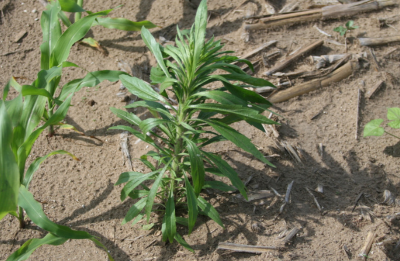 Bolted Marestail (GROWMARK, Inc.)
Bolted Marestail (GROWMARK, Inc.)
- Fall-applied herbicides are a valuable tool to manage tough-to-control weeds like marestail.
- Fall herbicides may allow for an earlier start the following spring, as soil temperatures warm up and dry faster when weeds are eliminated in the fall.
- Winter annual weeds like henbit and purple deadnettle can be hosts of soybean cyst nematodes and attract black cutworm moths in the spring.
- The use of residual herbicides in early fall will help mitigate weed emergence late in the season.
In recent years, the use of fall-applied herbicides has provided many springtime weed management benefits. Fall-applied herbicides can be very effective at managing annual and perennial weeds such as marestail and thistles, respectively. Additionally, fields where weeds are managed in the fall are often the most weed free in the spring. Elimination of weed cover and growth in the fall allows the soil to dry out and warm up more rapidly and ultimately allows for an earlier start of the season the following spring. Winter annual weed control can also provide additional benefits as it relates to insect, disease, and rodent populations. Insects such as wireworm, white grub, and black cutworm adults preferentially lay eggs in fields with green vegetation in the spring. Similarly, wildlife animals, such as voles, are less likely to invade weed-free fields.
A combination of growth regulators such as dicamba + 2,4-D (Radar™ brands) should provide adequate control of annual and perennial broadleaf weeds. If the weed population contains winter annual grasses and broadleaf weeds, a mix of a growth regulator (Radar or dicamba) and glyphosate (Bullzeye™ brands) should be considered. However, the lack of an adequate residual component with these programs may allow new weeds to emerge later in the season. Applications made early in the fall may fail to protect against late season seed germination. Consequently, early applications should include a residual herbicide. The potential downside of using a fall residual herbicide is reduced rotational flexibility. Some residual herbicides will allow you to plant corn and soybeans without restrictions the following season, while others will limit crop rotation options. Crop rotation restrictions will also vary with the rate of herbicide used, so always read and follow the product label and plan accordingly. Herbicide applications made towards the end of fall are unlikely to benefit from the inclusion of a residual herbicide.
It is important to remember that fall herbicide applications are not a substitute for spring residual herbicide applications. Weeds are more easily controlled if never allowed to emerge, so incorporate spring residual herbicides followed by in-crop applications to control summer annual weeds, including waterhemp. For questions about fall herbicide applications on your farm, reach out to your local FS Crop Specialist.

Marestail Rosette